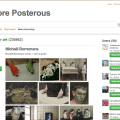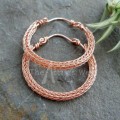It’s pretty understandable that, as a creative person, you may be curious about the potential advantages of blogging about your art. However, the thought of writing about your practice in this way can also be quite intimidating.
There may seem to be so many different ways in which an artist can get blogging ‘wrong’. Perhaps you’re worried about the possibility of alienating your audience with the wrong kind of content, or not posting often enough, or having an unfocused approach to your blog.

So, be sure to consider the following three questions before you start hammering that keyboard.
1. What type of blogger are you?
This is one of the first questions that you will have to answer as an artist blogger. Bloggers come in so many different types — some are unashamed hobbyists, others might bring a lot of expert and specialist knowledge to their writing, and others may prefer the consummately professional approach, treating their blog like an extension to a highly business-like artistic practice.
To get a sense of your answer to this question, consider your motivation. Why are you even thinking about blogging as an artist? Is it simply to ‘get your art out there’? Maybe you want to share tips on the more mundane aspects of artistic practice that go uncovered by other blogs? Or perhaps you wouldn’t consider blogging as an artist to be worthwhile unless it led to an uptick of interest in and opportunities for your practice?
2. How frequently should you post?
You might not think this should be a pressing issue for an artist blogger compared to other types of blogger. After all, you’re a mercurial artist, right? You’ll post an update whenever you find the time or inspiration, whenever you make a big breakthrough with your practice, whenever you discover a new technique or invest in that etching press — you get the idea.
Alas, this is a sure recipe for an abandoned blog, of which there are already far too many littered across the internet. Yes, even artists need to be methodical about this kind of thing if they wish their blog to attract the loyal base of readers needed for sustained success. As a rule of thumb, we would therefore suggest that you publish a new blog post at least once a week.
If that sounds a little daunting, consider writing all of your blog posts for the month in advance and scheduling their publication so that even when you’re busy, your readers will always be greeted with fresh content.
3. What format should your blog posts be?
While we obviously can’t dictate how you should write as an artist blogger. The likelihood is that your posts will end up resembling one of a number of well-known and proven formats.
For example, you might find yourself writing list articles, which consist of a series of generally numbered points, complete with a catchy title. Think something like “7 things you never knew about X”, or “10 reasons why you should do Y”. Readers seem to love list articles, perhaps because they’re so easily digestible and it’s obvious what kind of content they will be reading before they start.
But there are many other potentially highly effective formats out there for an artist’s blog post. Many blog posts by artists are, of course, heavy on photos, and the tip here is to make those images as big, beautiful and interesting as possible, without overwhelming your readers by including more accompanying text than strictly necessary. (Check out our guides on how to take compelling photos of your art and how to digitise your artwork.)
Another possibility is that you write a ‘how to’ post, perhaps on a certain painting or printmaking technique. This is a great opportunity to incorporate a video to really drum in the lessons imparted in the text, especially if you’re videogenic and a good verbal and visual communicator.

Or, if your goal with your artist blog is to give your readers a closer look at your practice, you might want to consider how you can tell a compelling story that prevents your article from being too dry or boring. Perhaps you could take readers on a journey through your experimentation with a certain technical process, or what you learned when you took on an art short course.
With other popular formats for artist blog posts ranging from previews or reviews of exhibitions to interviews or profiles of artists, gallerists and other key figures with whom you may work, there’s plenty of scope to switch things up on a consistent basis to really stimulate and excite your visitors.
It’s time to give it a go
The above, of course, only touches on a small fraction of the issues that you will have to contend with as an artist blogger. Nonetheless, they will hopefully give you a little well-timed inspiration for your efforts in this sometimes overlooked channel for promoting and discussing your art.
What have been your own experiences of blogging as an artist? Feel free to share your thoughts in the comments section below, or read more about why you shouldn’t delay in starting your own artist’s blog.
Related reading
How to write effectively about your own artwork
How to get your artwork recognised through social media
This post was originally published in July 2017. Last updated: October 2021.







